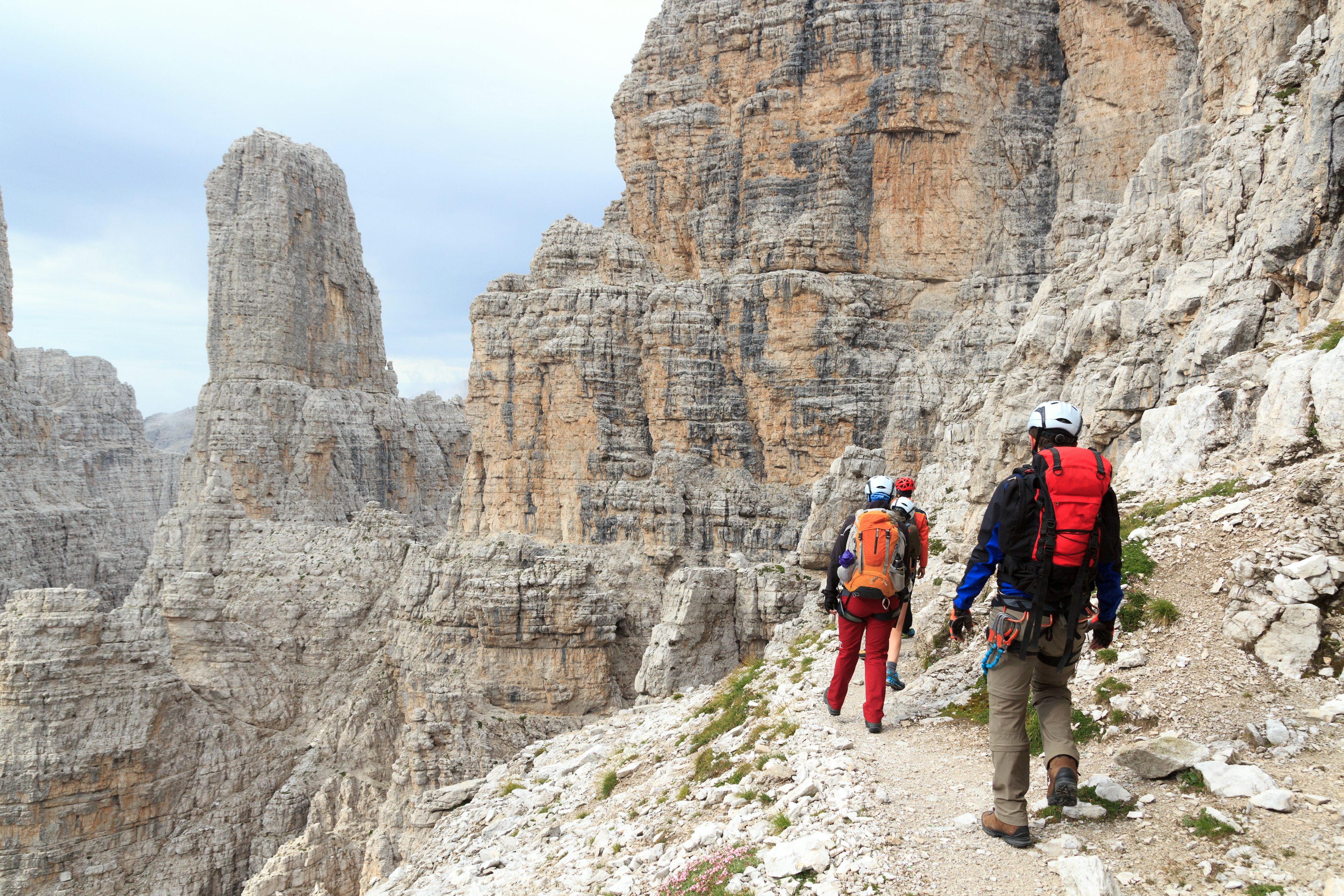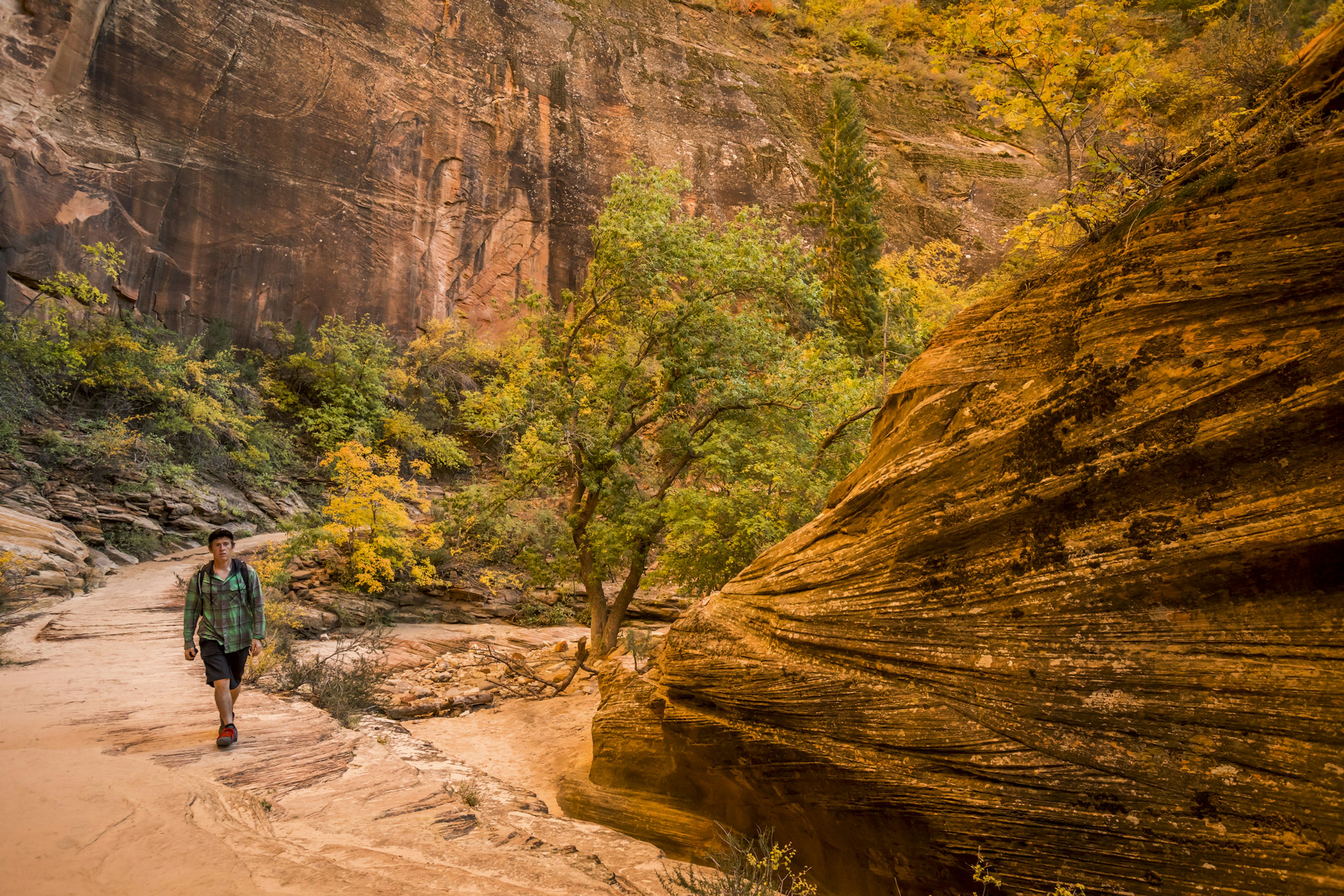Soaring over the provinces of Trentino and Alto Adige in northern Italy, the Dolomites are the Alps in overdrive.
These mountains don’t just deliver height (though the mightiest peak, glacier-capped Marmolada, does top out at 3343m / 10,968ft). They’re about drama. These Dolomites whoosh up like natural fortifications – sheer, big-shouldered and rugged – above an insanely lovely spread of flower-speckled pastures, river-woven valleys, glittering lakes and deep, dark forests. And it’s hard to do justice to the sunsets in the region, when the fading light pinkens limestone summits.
Sound like hiking terrain to you? You’re in luck. Whether you’re clipping on to one of the region’s famous vie ferrate (fixed climbing routes), skirting a lake or hustling up to a mountaintop rifugio (hut) for a bowl of barley soup or plate of buttery dumplings before a downhill scramble, the treks in the Dolomites are varied and rewarding.
Prime time for hitting the high trails is June to September (avoid the school summer holidays for fewer crowds and better chances of scoring a bunk in a hut), but at lower elevations the season extends from April to October.
Read on for five can’t-miss hiking experiences in the Dolomites.

1. Alta Via 1
Most legendary Dolomites hike
120km (75 miles), 7–9 days, moderate
The Alta Via 1 is the marquee expedition every savvy hiker wants to bag: the ultimate week-long hut-to-hut stomp through some of the most sensationally wild scenery in the Dolomites. You’ve heard the hype and seen the photos: great fangs of limestone poking above jewel-colored lakes; clifftop rifugi that look as they’ll blow away with the merest gust of Alpine air; ridgetop paths and rocky scrambles to top-of-the-beanstalk viewpoints; fiery sunsets and sunrises.
This one delivers the whole epic lot.
Starting at glass-green, peak-rimmed Pragser Wildsee (Lago di Braies) near Dobbiaco, the waymarked trail carves a path south to its end at La Pissa bus stop, where you can catch a ride on to the Renaissance town of Belluno.
While you’ll find your own magic moments, you’ll for sure rave about the stunning sight of the jagged Cinque Torri rock formations; the glinting Marmolada Glacier; and the hike’s high point, 2752m-high (9029ft-high) Rifugio Lagazuoi, where you can sleep in a bunk and wake up to soul-stirring views of the mountains beyond.
The trail is best hiked from June to September. Dodge peak summer for quieter trails and huts, and be sure to book rifugi stays well in advance. Most of the path is moderately challenging; be prepared for the odd stiff ascent and exposed stretch.

2. Tre Cime di Lavaredo (Drei Zinnen)
Best high-drama half-day hike
10km (6.2 miles) round trip, 4 hours, moderate
Madre Natura blessed just about every corner of Italy – but she went the extra mile in the Sexten Dolomites, which rise in the country’s northeast corner, at the border with Austria. These cloud-scraping limestone spires, buttresses and towers sheer high above meadows, lakes and spruce forests, making for compelling walking terrain. If you’re going to squeeze in a half-day hike here, make it the Tre Cime di Lavaredo Circuit in the Parco Naturale Tre Cime.
Kicking off at Rifugio Auronzo, the trail weaves to Rifugio Lavaredo before clambering up to 2454m (8051ft) Forcella di Lavaredo. From there, the Tre Cime will come into spectacular view: a trilogy of photogenic peaks shaped like bishops’ mitres. Then you’ll continue to Rifugio Locatelli and back to Rifugio Auronzo.
Get an early start to appreciate the trail at its silent best (it can get busy as the day goes on, especially during the summer) and avoid afternoon thunderstorms. Access the route via the toll road from Misurina (€30).

3. Alta Via 2
Best hardcore, multiday hike
160km (99 miles), 11–14 days, challenging
You’ll never regret devoting a fortnight to this beast of a trek – or regret it, as this is the Dolomites hike that separates the casual walker from the serious hiker. You’ll need to be fit, with the will and stamina for relentless climbs up and down slippery slopes of loose rock and scree; traversing mountain passes; and clipping onto vie ferrate, with ladder-like rungs and cables to help negotiate the most dizzyingly exposed sections.
And it’s worth every drop of sweat and blister. Spectacularly positioned rifugi en route lighten the load, at least.
Leading from Bressanone (Brixen) in the north to Croce d’Aune near Feltre in the south, the physically demanding trek takes a deep dive into the wilds of the Dolomites, with a whopping 11,884 m (38,990 ft) of elevation gain. It’s well marked with signs and red-and-white paint splashes on handy rocks.
We could wax lyrical about the pinch-yourself beauty of the morning light rising above the battlement-like peaks of the Sella Massif, or the out-of-this-world views from the trail’s high point, 2885m-high (9465ft-high) Forcella Marmolada – but seeing really is believing with this one. September is a peaceful time to hike the trail, thanks to crystal-blue skies, lighter crowds and pops of fall color.

4. Rifugio Nuvolau and Cinque Torri Loop
Best loop hike
12km (7½ miles), 3½-4 hours, moderate
A tantalizing intro to the Dolomites’ cinematic beauty, this circular walk skips from hut to gorgeous hut over a mood-lifting half-day just west of the glamorous Alpine town of Cortina d’Ampezzo. Strap on boots and a day pack for a memorable romp through the high Dolomites; the journey begins and ends at the Col Gallina parking lot on the 2105m (6906ft) Passo Falzarego.
As you steadily climb, you’ll be bombarded with photogenic scenery, starting with mountain-rimmed Lago di Limides, a stained glass-blue lake that reflects jagged peaks like 3225m-high (10,581ft-high) Tofana di Rozes (come at sunrise or sunset to see it in full blush). Yet the absolute highlight is the aerie-like Rifugio Nuvolau – the oldest hut in the Dolomites, built in 1883, and perched precariously atop the rocky summit of 2575m-high (8448ft-high) Monte Nuvolau. The 360-degree views from here are quite something. Stop for hot chocolate, a bowl of canederli in brodo (dumpling soup) or a plate of polenta with goulash. Refueled, you’ll hike on via the rustic Rifugio Scoiattoli; Rifugio Cinque Torri, with front-row views of its five namesake crags; and crystal-clear Lago Bai di Dones, flanked by pine and fir trees.
You can hike this one from June to October; the shoulder seasons are inevitably less crowded. History fan? In the Cinque Torri area, keep your eyes peeled for WWI-era trenches and shelters.

5. Parco Naturale Adamello Brenta
Best hike for wildlife spotting
Times, distances and levels of hikes vary
West of the main Dolomites range, this natural park – Trentino’s largest protected area – is the a dream for mountaineers and via ferrata fans, thanks to its spiky peaks, sheer-rock walls and knuckle-whitening ascents. And this UNESCO Global Geopark is also fabulous terrain for old-school hiking, with its wondrous tableau of waterfalls; wildflower-freckled meadows (best in spring); fir, beech and larch forests (lovely in autumn); ice-blue and bottle-green lakes; and (naturally) backdrop of saw-toothed peaks. The crowning glory is the vast Adamello glacier, the largest in the Italian Alps.
Here, it’s less about choosing one iconic trail and more about immersing yourself in nature – and seeing where the mood takes you. Perhaps, say, to Lago di Tovel, where a 4km (2½-mile), 1½-hour hike loops around a forest-fringed lake of eye-popping turquoise. A greater challenge, you say? Take the cable car up to 2439m (8002ft) Passo di Grostè for a high-level, 9½km (6-mile), 3½-hour hike to Rifugio Tuckett – and arresting views across the Brenta Dolomites.
Bring pocket binoculars, as the park teems with wildlife: red deer, chamois, marmots and elusive brown bears on the ground, and golden eagles, hawks and owls in the sky.






